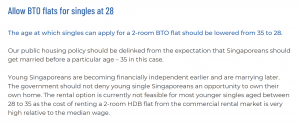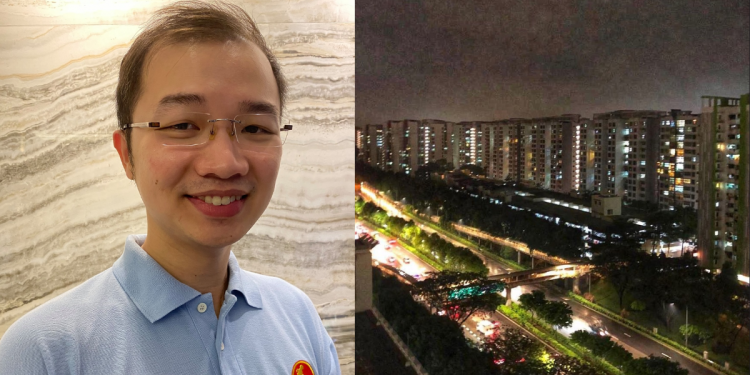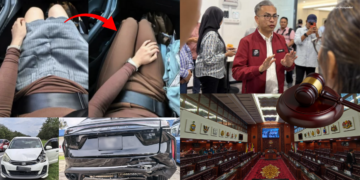MP Louis Chua’s Adjournment Motion on Housing Needs of Singles and Singaporeans
In Parliament earlier today (13 September 2022), Workers’ Party MP Louis Chua delivered an adjournment motion titled “Ensuring Housing Needs of Singles and Singaporeans are Met”.
In his speech, which is set out in full in this article, Mr Chua covered issues ranging from affordability, supply, and pioritising families.
One highlight of his speech is his argument that the BTO eligibility age for singles should be reduced from 35 to 28. This was a point that can also be found in the Workers’ Party’s manifesto from the 2020 General Elections.

Louis Speech in Full
Mr Speaker I would like to first declare my interest as an equity research analyst in a financial institution, covering the real estate industry.
Mr Speaker, the adequacy of HDB housing for singles has arisen in public and parliamentary discussions ever so often, showing this remains an important and evolving issue in Singapore. Over the years, public housing options for singles have gradually expanded ever since the introduction of the Single Singapore Citizen Scheme in 1991. However, since the scheme’s inception almost 30 years ago, one key policy requirement has remained unchanged – that singles must be at least 35 years old to be eligible to purchase public housing.
At the same time, recent headlines reporting record high HDB resale prices, suggest that something is amiss in public housing provision, even for couples.
As set out in The Workers’ Party Manifesto, and as reiterated by LO Mr Pritam Singh in the MND COS debate earlier this year, we believe this threshold can and should be lowered, and we propose to lower the BTO eligibility age for singles to 28 years, which is when most Singaporeans would have been in the workforce for a few years and have begun to lead more independent lives.
This proposal would be a critical change, yet a continuation of the Government’s efforts over the years to expand HDB options for singles, while still allowing HDB to give priority to providing for families. In fact, we believe lowering the threshold for owning HDB flats to 28 years would go a long way towards HDB’s stated aims for Singapore’s public housing to be “inclusive” and to “reflect the diversity of our society”.
The most pressing issue: supply and availability
The objective of today’s adjournment motion is two-fold, to ensure that the housing needs of not just singles, but that of all Singapore are met. Before I move on to state my case on why singles should be allowed to apply for a BTO flat at an earlier age, I would like to touch on the most pressing issue in my view, and that is housing supply. I would like to implore the Government to take urgent and decisive steps to increase the availability of public housing and address the current demand-supply imbalance, to ensure that the housing demand of all Singaporeans, not just singles, can be met.
In response to my adjournment motion last year on Supporting Diverse Aspirations Through Rental Housing, SMS Sim Ann shared that home ownership has been and will continue to be our key housing strategy for Singapore. Since this is the Government’s position, I hope that the Government can take steps to deliver on this strategy.
I acknowledge that compared to last year, housing supply is set to increase by about 35% over the next two years, at about 23,000 BTO flats per year in 2022 and 2023. Moreover, the HDB stated that it is prepared to launch up to 100,000 flats in total from 2021 to 2025, if needed, subject to prevailing demand. These numbers, however, need to be put in context.
Even if the HDB decides to launch the whole 100,000 flats in total from 2021 to 2025, this implies that BTO supply falls 20% to about 18,400 flats in 2024 and 2025. Moreover, while the average of 20,000 BTO flats between 2021 to 2025 is an increase compared to average of 17,000 flats between 2016-2020, this is still 13% below the average of 23,000 flats in 2011 to 2015, during the time when Mr Khaw Boon Wan was MND Minister and sought to address the backlog in HDB flats.
We have already seen BTO application rates climb steadily over the past decade to new highs. For 3-room and larger flats, this increased from 2.8x in 2012 to 6.1x in 2021. Similarly, 2-room flexi flats, whose buyers are more likely to be the elderly or singles, also saw application rates rise, albeit at a more moderate pace from 2.8x in 2012 to 3.6x in 2021.
What is of greater concern is that despite the supposed ramp up in supply this year, application rates have reached new record highs, suggesting that the level of demand-supply imbalance remains a critical concern. Following the February, May, and August BTO exercises this year, application rates for 2-room flexi flats and 3-room and larger flats have increased even further and reached new record highs, at 5.1x and 7.2x respectively this year. This is worrying, especially when we look at the recent August BTO exercise, where the overall application rates are seeing no signs of letting up, with that for 2-room flexi flats at 5.5x and that for 3-room and larger flats at 8.3x.
While I acknowledge that our proposal on singles’ BTO eligibility could increase marginal demand for 2-room flexi flats, it does not detract from the fact that there appears to be serious imbalances in the housing market, the spill over effects of which is evident for all to see in the secondary market, where HDB resale prices have increased by 25% in the last three years, with prices today 12% higher compared to just one year ago, and prices showing no signs of slowing down, increasing by 2.8% in just the last three months alone.
So, I hope the Government will seriously prioritise its resources to support Singaporeans in achieving their home ownership aspirations.
To Reduce BTO Eligibility Age to 28
Moving on to reducing the BTO eligibility age to 28 for singles. By the age of 28, the average Singaporean male and female would have finished their tertiary studies and had some amount of time in the workforce. In that sense, they would have some chance to lead independent lives and steady their financial footing.
As shared by LO Pritam Singh earlier this year, in the NYC’s 2021 publication on the state of youths in Singapore, when it comes to aspirations or life goals in life, the top choice selected by our youths was to maintain strong family relationships while the second choice was “to have a place of my own”.
Our proposal looks at reducing the BTO eligibility age to 28, and not that for the resale market. While opening the resale HDB market to singles below 35 is a possibility worth exploring, we think it is important to first enable singles to access the BTO market, to ensure that incremental demand is met through new supply and not through existing supply and via the currently buoyant HDB resale market. Moreover, with a waiting time of up to 5.7 years as of the August 2022 BTO launch, assuming one is successful in balloting for a flat on the first attempt at age 28, he or she would already be close to 35 years old by the time the flat is in a move-in condition. No different from purchasing a resale HDB flat anyway.
Ensuring home ownership aspirations can be affordably met
Affordability is also a key consideration when it comes to meeting singles’ housing needs. Now while first-timers can access various financial support grants from the age of 21 to aid in their purchase of a flat, this is, at this point not available to singles. That said, I recognise that single buyers too have access to housing grants and can buy smaller BTO units in non-mature estates. Should the eligibility age be reduced, I believe singles can avail themselves of such grants too, thus supportive of singles’ home affordability. If the Government has budgetary concerns or believe that younger singles should not be incentivised to buy a place of their own, the level of housing grants accorded can be on a graduated scale, where grants provided for 28-year-olds are at a discount to the full enhanced CPF housing grants, with an annual step-up to the current eligible age of 35.
Yet, singles aged below 35 who wish to have a place of their own today would have to either purchase a private residential property, which needless to say is significantly more expensive than public housing, or rent a flat in the open market. However, even in the HDB rental market, many singles would be priced out of the market if they wish to rent a place of their own. Median rents for a 3-room HDB flat are currently about S$2,000 a month, which is essentially the entire take home salary of a polytechnic graduate today.
The purchase of a BTO 2-room flexi flat on the other hand, are a lot more affordable. Based on indicative prices of close to S$100,000 for a 2-room flexi flat in non-mature towns in the latest August BTO launch, the monthly repayment amount over a 25-year period is only around $400 a month. A fraction of what it costs to rent in the open market.
So, while it is abundantly clear that many Singaporeans who may be single for various reasons before the age of 35 would like to have a place of their own, many simply cannot afford to do so. Should we not look into further enabling single Singaporeans to meet their housing needs and aspirations?
30 years of expanding HDB options for singles – above 35 years old
Mr Speaker, when we look back at the time before the introduction of the Single Singapore Citizen Scheme, the original rationale for excluding singles from owning HDB flats was: first, to prioritise BTOs for families as the use of space in land-scarce Singapore was not optimised; and secondly, that home ownership by singles was supposedly inconsistent with Government social policy of encouraging marriage and preserving the traditional family unit.
The change in policy came about in 1991 by allowing singles over 35 to buy resale HDB flats but limited to three-room flats in selected locations.
The rules were further relaxed over the years, but the next big break came in 2013 when singles over 35 were for the first time allowed to buy new, subsidised two-room flats directly from the HDB.
Mr Speaker, the introduction of the Single Singapore Citizen Scheme, and the developments that followed, showed that the Government can be responsive to the changing demographics of society.
In fact, Minister for National Development Desmond Lee recently reassured Singaporeans that the Government cares about housing for singles, when he said at the Singapore Economic Policy Forum on 29 Oct 2021: “Some Singaporeans remain single for a variety of reasons, including obligation to family and parents, or a matter of choice, or a matter of life course. But many still want or need their own living space. They may wonder if we care about their housing needs. To these Singaporeans, let me assure you: we do. We recognise your needs, your aspirations, and your sacrifices. That’s why we’ve in fact been expanding housing options and grants for singles over the years.”
However, 30 years on from the introduction of the Single Singapore Citizen Scheme, singles below 35 remain largely precluded from owning their own HDB flat. While there have recently been welcome exceptions carved out for certain special situations, such as for single parents, the general threshold of excluding singles below 35 years of age seems to have been retained by default since 1991, despite changing demographics and societal mindsets.
This rule has serious implications on the growing number of singles under 35, depriving them of the security of home ownership if they are priced out of the private market, the private and HDB rental market and not having a place to call their own and build their own lives. More importantly, current policy signals to single Singaporeans that their marital status, whether by choice or due to factors beyond their control, is somehow viewed as undesirable and undeserving of Government support for home ownership.
35 years threshold less relevant as Singaporeans stay single for longer
Mr Speaker, implicit in the HDB exclusion of singles under 35 is the expectation that Singaporeans should get married before turning 35 years old, and that up until that point, single Singaporeans will live with their parents. While this traditional life progression might have been more relevant back in 1991, we know now that Singaporeans are staying single for longer for myriad reasons, and not necessarily moving straight from their parents’ home into a matrimonial home.
Contrary to popular belief that the younger generation are eschewing marriage, surveys have shown that many single Singaporeans still want to get married. In fact, over the last 20 years, the general marriage rate for resident males and females have been consistent at 43.3 for males and 40.2 for females. The latest datapoint on general marriage rates in 2021 is even higher on a year-on-year basis for both males and females, at 45.3 and 44.2, respectively.
What has changed is that Singaporeans are staying single for longer and getting married later in life. Based on data from Singstat, the proportion of singles among citizens in the 30-34 years age group is now at a record high of 42.2% in 2021, increasingly steadily from 27.6% in 2000 and 36.9% in 2010.
A 2013 survey conducted by the IPS sheds some light on why Singaporeans are getting married later in life. The IPS found that, among respondents who wanted to get married, the key reasons for their getting married later in life than their ideal age were “the delayed acquisition of the markers of adulthood,” and “not having a suitable partner.”
At the same time, data shows that more young people are moving out of their parents’ home even before marriage. DOS data shows that between 2017 to 2020, the number of persons aged below 35 years old and living alone has almost doubled from 12,300 to 25,000. There are of course those who are neither living with their parents nor living alone. But there are also a considerable number who while still living with their families, do not have the financial ability to live on their own as much as they desire to do so. While it can be argued that some singles might have needed to move out given working from home requirements during the pandemic, many others have expressed a yearning simply to lead more independent lives in their early adulthood.
The data and trends highlight the negative effects of excluding those under the age of 35 from owning HDB flats, and considering these developments, it behoves the Government to revisit the issue and assess the validity of the main arguments against HDB ownership by singles under 35.
HDB can and should still prioritise families
Mr Speaker, one of the key arguments for limiting singles’ ability to buy HDB flats relates to the allocation of resources: that in land-scarce Singapore, flats should be prioritised for families over singles.
To this point, I am comforted by PM Lee’s comments during the National Day Rally earlier this year, where he shared that and I quote, “We have done our studies and planning. We will have enough space for future generations. Our problem is not finding the space to build enough flats, nor keeping homes affordable for Singaporeans. We know how to do that.”
Putting the issue of land scarcity aside, I would like to make three points on the issue.
First, data from past BTO exercises show clearly singles do not compete with young couples and families for the same type of flats in non-mature estates. The data show that young married couples overwhelmingly apply for 3-room or larger BTO flats and very few apply for 2-room flats, whereas singles are limited to buying only 2-room flexi BTO flats.
For example, in the BTO exercises since 2015, the application rate for 2-room flexi flats among first timers have consistently been less than 1x, while that for 3- room or larger BTO flats have consistently been multiple times oversubscribed. Moreover, first-timer singles can only apply for 2-room flexi flats in non-mature locations, with a cap of 65% of the balance 60% of such flats meant for non elderly applicants; in other words, at most 39% of such flats.
This shows that even without making any adjustments to the unit mix of various types of flats, lowering the minimum age threshold for singles to buy a BTO flat from 35 to 28 is expected to have a minimal impact on young couples’ likelihood of securing a flat.
Secondly, we are in full agreement that public housing policy should provide extra support and incentives to young couples and budding families. Having said that, providing support for young couples and families should not be viewed as mutually exclusive from expanding HDB options for singles. For instance, the Government can loosen the BTO eligibility criteria for singles without in any way impinging on the subsidies and other benefits given to young couples, which may even be enhanced.
Thirdly, even if there were to be a question on the allocation of limited resources, such an exercise will always be a balancing act conducted in accordance with Government priorities and, more importantly, guided by fundamental principles and values. Our current policy measures haves been described as imposing “anti-single penalties,” and which unknowingly becomes signals to singles that their marital status, whether by their own volition or not, is viewed as undesirable and undeserving of Government support for home ownership.
Supporting singles does not detract from marriage and family formation
The next key argument against singles owning HDB flats is that it is somehow in conflict with the Government’s goals of encouraging marriage and family formation.
If this hypothesis were true, then we might see an immediate dip in marriage rates for singles over 35 years old who have been able to buy an HDB flat of their own. To test this, we looked at the number of marriages in the 35- to 39-year-old age group at two key points in time when HDB options for singles were expanded: after October 1991 when the Single Singapore Citizen Scheme was first introduced; and after July 2013 when singles were allowed to buy 2-room BTO flats in non-mature estates.
The data showed that in the three-year period from 1992 to 1994, as well as from 2014 to 2016, marriage rates and the number of marriages for both males and females in the 35- to 39-year-old age group went up instead of falling. We accept that this could be a simple coincidence of timing between housing policy and marriage rates, which are of course affected by multiple factors, and do not necessarily imply causation. However, the data does suggest that we need not be too circumspect about expanding HDB options for singles as a factor that will singlehandedly cause a further delay or decline in marriages. On the contrary, allowing singles to have a home of their own might even encourage marriage and family formation.
Conclusion
Mr Speaker, this adjournment motion does not call for a major overhaul to the policies that are in place today. I hope we can firstly, take urgent and decisive steps to increase the availability of public housing and address the current demand-supply imbalance; and secondly, lower singles’ eligibility age for HDB BTO flats from the current 35 years to 28 years.
I am comforted that there is a slight reallocation of 2-room flexi BTO flats in non mature areas for singles, with up to 65% of the non-senior 2-room Flexi flats in non-mature estates will be set aside for first-timer singles, an increase from up to 50% currently. This, however, only means a marginal increase of at most 9% of 2-room flexi flats in only non-mature estates available.
As elected Members of Parliament, we are given a mandate from and by the people we serve. We therefore must lend a listening ear to the generation ahead of us and ensure that our public housing policies are both inclusive and reflective of the diversity of our society.
SMS Sim Ann shared last year that beyond just a roof over our heads, home ownership has provided Singaporeans with a sense of stability, security and belonging, and has given us a strong stake in our country’s progress. In this spirit, I hope the Government can consider the points I have raised in this speech and ensure that the housing needs of singles and all Singaporeans are met.
Since you have made it to the end of the article, follow Wake Up Singapore on Telegram!





